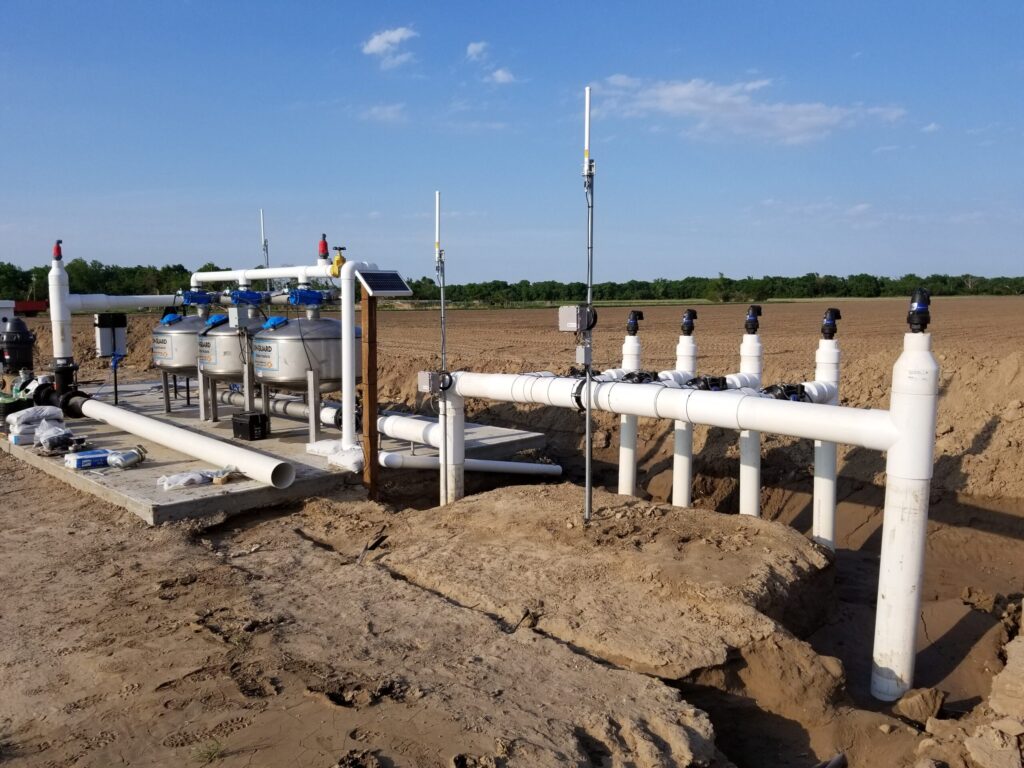What Farmers Need to Know Before Switching to Subsurface Drip Irrigation
What Farmers Need to Know Before Switching to Subsurface Drip Irrigation
Farms using subsurface drip irrigation (SDI) have reported water savings of over 50% and crop yield increases of up to 30%. This highly efficient irrigation method delivers water and essential nutrients directly to the root zone of plants, minimizing waste and maximizing growth. As water conservation becomes increasingly critical, SDI is gaining popularity as a powerful solution for improving farm productivity and sustainability.
If you are considering this technology, making an informed decision is crucial. This guide will walk you through the key considerations for transitioning to an subsurface drip irrigation system. You’ll gain the knowledge needed to determine if this investment is right for your operation, from understanding the fundamentals to calculating the long-term financial returns.
Understanding Subsurface Drip Irrigation (SDI)
Before making a switch, it’s important to grasp the core concepts of SDI and how it differs from other methods.
How SDI Works
SDI operates by burying drip tape or tubing beneath the soil surface. This network of lines delivers water and nutrients slowly and directly to the plant’s roots. By applying water below ground, SDI virtually eliminates surface evaporation and runoff, ensuring that nearly every drop is used by the crop. This precision allows for consistent moisture levels in the root zone, which is ideal for healthy plant development.
Key Components of an SDI System
A complete SDI system is composed of several essential parts working together:
- Water Source and Pump: The system starts with a reliable water source, such as a well or reservoir, and a pump to provide the necessary pressure.
- Filtration System: This is arguably the most critical component, designed to remove sediment, minerals, and organic materials that could clog the drip emitters.
- Pressure Regulators: These devices ensure that water pressure remains consistent throughout the system for uniform water distribution.
- Mainlines and Submains: Larger pipes that transport water from the source to the individual field plots.
- Drip Tape/Tubing: The network of buried lines with built-in emitters that release water into the soil.
SDI vs. Other Irrigation Methods
Compared to traditional irrigation methods, SDI offers distinct advantages. Furrow and flood irrigation often result in significant water loss through evaporation and deep percolation. Center pivot systems, while more efficient than flood, can still lose a substantial amount of water to wind and evaporation before it reaches the ground. SDI delivers water with over 95% efficiency, requires less labor once installed, and offers precise control over water and nutrient application. However, the initial installation cost for SDI is typically higher than for these other methods.

Assessing Your Farm’s Suitability for SDI
Not every farm is a perfect candidate for SDI. A thorough evaluation of your land, water, and cropping system is necessary.
Evaluating Soil Type and Topography
The characteristics of your soil and the slope of your land will heavily influence the design of an SDI system. Sandy soils allow water to move downwards quickly, requiring emitters to be spaced closer together. Clay soils hold water longer and allow for wider lateral movement, so emitter spacing can be greater. A professional site evaluation is essential to map topography and create a design that ensures uniform water distribution across varying elevations.
Analyzing Your Water Source and Quality
The quality of your water is a critical factor. Water must be tested for sediment, minerals like iron and manganese, and biological contaminants such as algae, all of which can clog emitters. Your water source must also provide a sufficient flow rate and pressure to meet the system’s demands. An inadequate water source can lead to poor system performance and crop stress.
Considering Crop Type and Tillage Practices
SDI is highly adaptable and can be used for a wide range of crops, including row crops like corn and cotton, as well as orchards and vineyards. However, the system’s design must be compatible with your tillage and field operations. For example, the depth of the drip tape must be chosen carefully to avoid damage from tillage equipment. If you practice deep ripping, an SDI system may not be suitable without adjusting your tillage methods.
Key Benefits of Switching to SDI
Superior Water and Nutrient Efficiency
One of the biggest advantages of subsurface drip irrigation (SDI) is its ability to deliver water directly to the root zone. Unlike sprinklers or flood irrigation, which lose significant amounts of water through evaporation and runoff, SDI minimizes waste. Farmers often report water savings of 25–50% or more.
Nutrients also become more efficient through fertigation—the process of injecting liquid fertilizers into the irrigation system. This ensures nutrients go exactly where they’re needed, at the root level, rather than being lost to the atmosphere or leached deep into the soil. The result is smarter use of water and inputs, with less waste and higher returns.
Improved Crop Health and Yield
Crops thrive when they have consistent access to the right balance of water and nutrients. SDI maintains uniform soil moisture, which reduces plant stress and leads to stronger root systems. Healthier plants are less prone to fluctuations caused by drought or irregular watering.
Farmers who adopt SDI often notice better uniformity across their fields, meaning fewer underdeveloped plants and more consistent harvests. In many cases, yields increase significantly—not just because of more water, but because the crops are more resilient and nutritionally supported.
Reduced Weed Growth and Fungal Disease
A hidden but valuable perk of SDI is that it keeps the soil surface dry. Since water is applied underground, weed seeds on the surface receive less moisture, resulting in fewer weeds to compete with crops.
Additionally, SDI lowers the risk of foliar diseases, which thrive in damp environments created by overhead irrigation. By keeping foliage dry, farmers can reduce the incidence of fungal infections, saving both time and money on crop protection treatments.
Potential Challenges and How to Mitigate Them
Clogging Risks and Filtration Requirements
The biggest challenge with SDI is clogging. Emitters can quickly become blocked by sediments, minerals, or organic matter in the water supply. The solution lies in a well-designed multi-stage filtration system—using sand media, disc, or screen filters to keep water clean. Regular flushing and inspections ensure the system stays efficient over time.
Damage from Rodents and Insects
Buried drip lines aren’t immune to pests. Gophers, insects, and other small animals may chew through the tubing. Preventive measures include installing lines at the proper burial depth and, if needed, using repellents or protective coatings. Regular field monitoring can help spot issues before they spread.
System Maintenance and Monitoring
SDI requires more consistent upkeep than many traditional methods. Tasks such as flushing lines, checking water pressure, and inspecting filters should become part of the farm’s routine. A well-maintained system can run smoothly for decades, while neglected systems may quickly become inefficient.

The Installation Process: What to Expect
Professional Design and Mapping
Before any digging starts, irrigation specialists carefully design the system. They use GPS mapping and hydraulic analysis to determine optimal line placement, emitter spacing, and flow rates. Elevation changes and field layouts are factored into the design for maximum efficiency.
Site Preparation and Trenching
Once the design is set, the field is prepared. Specialized trenching equipment installs the drip tape or tubing at a precise depth, ensuring roots can access water efficiently while protecting the lines from surface damage. Proper preparation at this stage prevents costly adjustments later.
System Assembly and Initial Testing
The final step is connecting all components—from pump stations and filters to drip lines and controllers. Before farmers rely on the system, a full flush and pressure test is conducted. This ensures every emitter is functioning correctly and that the system is ready for real-world use.
Western Irrigation: A Partner for Farmers
Who They Are and What They Do
Western Irrigation has built a reputation for helping farmers modernize their water management. With years of expertise, they understand the challenges of agriculture and provide systems that stand the test of time.
Custom Solutions for Different Farms
Every farm is unique, and Western Irrigation takes that seriously. They tailor SDI systems based on crop type, soil composition, and water availability. Their designs aren’t cookie-cutter; they’re engineered for long-term performance and efficiency.
Ongoing Support and Training
A great system is only as good as the farmer’s ability to use it. Western Irrigation doesn’t just install systems; they provide ongoing training and technical support, ensuring farmers understand scheduling, fertigation, and maintenance to maximize returns.
Best Practices for Managing Your New SDI System
Developing a Strategic Irrigation Schedule
Unlike surface methods, SDI requires moving from “eyeballing” soil moisture to using data-driven scheduling. This includes tracking evapotranspiration (ET) rates, soil moisture sensors, and crop growth stages to deliver precise amounts of water exactly when needed.
Implementing a Fertigation Program
SDI allows fertilizers to be injected directly into the SDI system. To avoid damage, farmers should consider nutrient compatibility, proper dilution, and timing of applications. This ensures crops get steady nutrition without clogging the system.
Routine Inspection and Flushing Protocols
Regular maintenance keeps SDI efficient. Farmers should walk fields regularly to check for leaks, monitor pressure gauges, and flush both mainlines and submains to clear sediment. These small tasks prevent major problems and keep the system running like new.
Long-Term System Care and Sustainability
Preparing Your System for the Off-Season
Before shutting down for winter or dry seasons, it’s important to flush lines with cleaning agents, drain water from the system, and protect equipment from freezing or dust. Proper winterization prevents damage and extends system life.
Troubleshooting Common Issues
Pressure drops, uneven water distribution, and crop stress are common red flags. Learning to recognize these signs early—and addressing them with proper maintenance—saves time and prevents yield losses.
Planning for System Longevity and Upgrades
With proper care, SDI systems can last 15–20 years or more. Farmers should also plan for future technology upgrades, like smart sensors and automated controllers, to stay ahead of water challenges and improve sustainability.

Conclusion
Switching to subsurface drip irrigation offers unmatched efficiency in water and nutrient delivery, improved crop yields, and better long-term sustainability. But it also requires careful planning, proper filtration, and consistent maintenance to succeed. While the upfront investment can feel daunting, the long-term payoff—lower input costs, healthier crops, and stronger profits—makes SDI a game-changer for modern farming.
If you’re considering the switch, now is the time to act. Reach out to a qualified irrigation specialist or trusted partner like Western Irrigation to schedule a farm assessment and receive a detailed SDI plan tailored to your operation.
